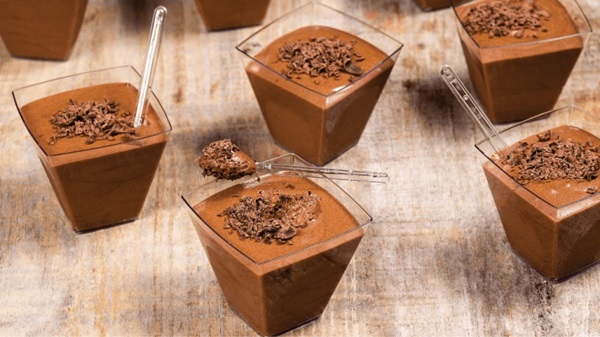National Mousse Day is observed on November 30 every year. People are excited to whip up some lovely-dovey sweetness for their near and dear ones. Whether you prefer the classic chocolate mousse, a tangy fruit mousse, or even a savory version, this holiday celebrates the rich and airy textures that make mousse so delightful. The word ‘mousse’ is derived from French which means ‘froth’ or ‘foam’. It became popular because of its light and fluffy nature, achieved by carefully folding whipped egg whites or cream into the mixture. In the 19th century, it found its way into the United States, evolving from its French roots into a global favorite.
History of National Mousse Day
Do you usually think of chocolate treats when you hear the word “mousse,”? Most people do! But interestingly, mousse was first concocted as a savory dish in 18th-century France. It was not until the second half of the 19th century that fruit mousses became popular.
The French would mix whipped cream with fruit, coffee, or liqueurs, or pour the cream on top in the shape of a pyramid. They called it ‘crème en mousse,’ meaning ‘cream in a foam’. Today’s mousse recipes have evolved from this old tradition. If you are not into whipped cream, you can try replacing it with some viciously whisked egg whites.
Moreover, chocolate mousse is the most popular type of mousse today which was not always so well-known. During the 1930s, it became popular in the U.S., and also in the same time chocolate pudding was also introduced into American food culture. You could say that chocolate mousse was inspired by pudding.
From a thick salmon mousse as a starter to a smooth raspberry mousse or the classic chocolate mousse for dessert, there is practically no limit to the flavors that a mousse can embrace. Whereas it also works as a filling in pastries and parfaits, a savory mousse goes well with cheese and fruit platters, turning them into good-looking appetizers.
In addition, usually, mousses are served cold, while sweet mousses are sometimes served frozen. The best thing about mousses is that it works well in both savory and sweet dishes. You can enjoy a rich salmon mousse as a starter a creamy raspberry mousse or a classic chocolate mousse for dessert.

The flavors you can create with mousse are almost endless. It also makes a great filling for pastries and parfaits, and a savory mousse pair nicely with cheese and fruit platters, making them look even more appetizing.
Today, savory mousses are made with ingredients like foie gras, shellfish, avocado, poultry, vegetables, and cheese in many restaurants. They are often served as a light entree or appetizer and are usually stabilized by adding gelatin.
| 1892 (The Mousse is Documented) | The first-ever documented record of chocolate mousse comes from a Food Exposition held at Madison Square Garden, N.Y.C. |
| 1897 (First Recipe Appears in Print) | The Boston Daily Globe publishes one of the first recipes for chocolate mousse, in its ‘Housekeeper’s Column.’ |
| Late 19th-century (Fruit Desserts Make an Entry) | The first sweet mousses make their entry into America, and they are fruit mousses topped with whipped cream. |
| 1930s (Mousse Introduced) | Chocolate pudding — the predecessor of chocolate mousse — is introduced into American food culture. |
Different Types of Mousse
One of the most exciting aspects of mousse is its versatility. This dessert can be adapted to suit various tastes and occasions, making it a favorite among chefs and food enthusiasts. Let’s explore some of the most popular types of mousse and what makes them special:
Chocolate Mousse
Chocolate mousse is perhaps the most iconic and beloved variation of this dessert. Rich and velvety, it’s a chocolate lover’s dream come true. The key to a perfect chocolate mousse is high-quality chocolate, which should be melted and gently incorporated into the whipped base. Some recipes call for a touch of coffee or liqueur to enhance the chocolate’s depth of flavor. Chocolate mousse is often garnished with whipped cream, fresh berries, or shaved chocolate for an extra layer of indulgence.
Fruit Mousse
Fruit mousse offers a lighter and more refreshing alternative to the richness of chocolate mousse. Common fruits used in mousse include berries, mangoes, and citrus fruits. The fruit is typically puréed and sweetened before being folded into the whipped mixture. The result is a dessert that’s both airy and bursting with natural fruit flavors. Fruit mousse is often served with a fruit coulis or a sprig of mint for added freshness.
Savory Mousse
While sweet mousses are the most popular, savory mousses offer a unique twist on this classic dessert. Ingredients like foie gras smoked salmon, or goat cheese can be whipped into a mousse, creating an elegant appetizer or side dish. Savory mousses are often served with crackers, toast points, or fresh vegetables, providing a rich and creamy contrast to the other elements on the plate.
Layered Mousse
For those looking to elevate their mousse experience, layered mousse desserts are a show-stopping option. These desserts typically feature multiple layers of different mousses, such as chocolate and raspberry, or white chocolate and passionfruit. The layers can be carefully stacked in glasses or molds, creating a visually stunning dessert that’s as delicious as it is beautiful.
5 Interesting Facts About Mousse
Thanks to electric mixers: The invention of electric mixers made mousse widely popular. It’s believed that Rufus Eastman invented the first electric motor mixer in 1885.
What a fish!: Fish mousse, once a popular dish in America when served with bread and butter, has become less common today. However, it is still enjoyed as a party dip by dedicated mousse fans.
Largest mousse in the world: Aventura Mall in Miami set a Guinness World Record for the largest chocolate mousse, which weighed around 496 pounds.
Why foamy?: When eggs and cream are beaten just right, they form air bubbles that give mousse its light and airy texture.
Hot or cold?: Mousse can be frozen to make ice cream or served hot.
Conclusion
In conclusion, National Mousse Day on November 30 is a celebration of the delightful and versatile mousse. From the classic chocolate mousse to fruity and savory variations, this day highlights the rich history and delicious diversity of mousse. Whether enjoyed as a sweet treat or a savory appetizer, mousse’s airy texture and wide range of flavors make it a perfect way to indulge and share with loved ones.
Frequently Ask Question
How did mousse become popular in the U.S.?
Mousse gained popularity in the U.S. during the 1930s, influenced by the introduction of chocolate pudding into American food culture.
What is the history of mousse?
Mousse originated in 18th-century France as a savory dish. Sweet fruit mousses emerged later, and chocolate mousse became well-known in the 1930s.
Can mousse be served in different ways?
Yes, mousse can be served cold, frozen, or even hot. It can also be used as a filling for pastries and parfaits, or as an elegant appetizer.
You may also like to read, National Cappuccino Day – November 8, 2024
